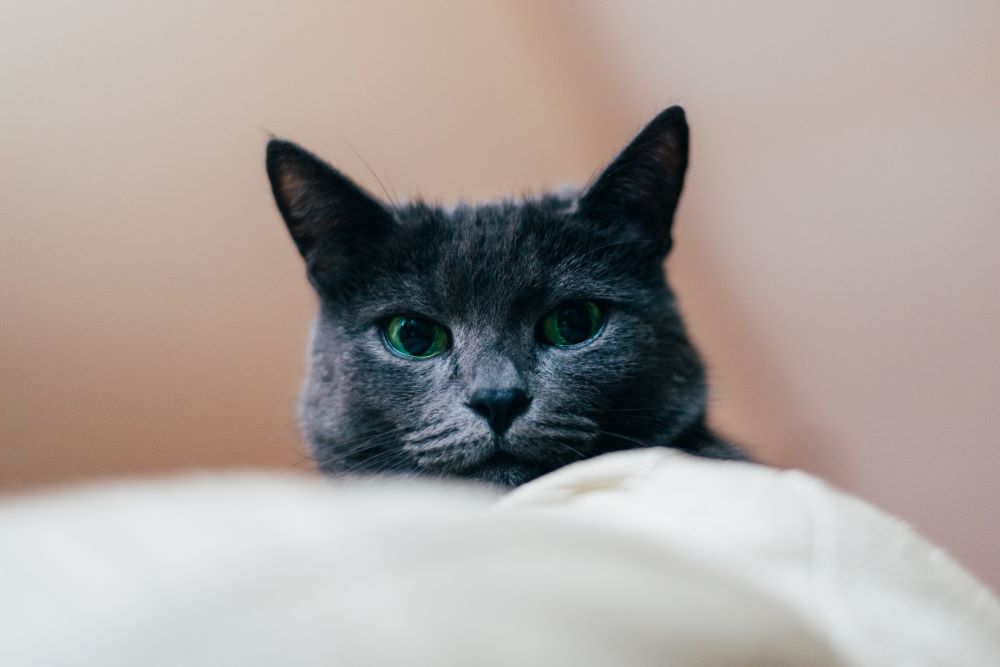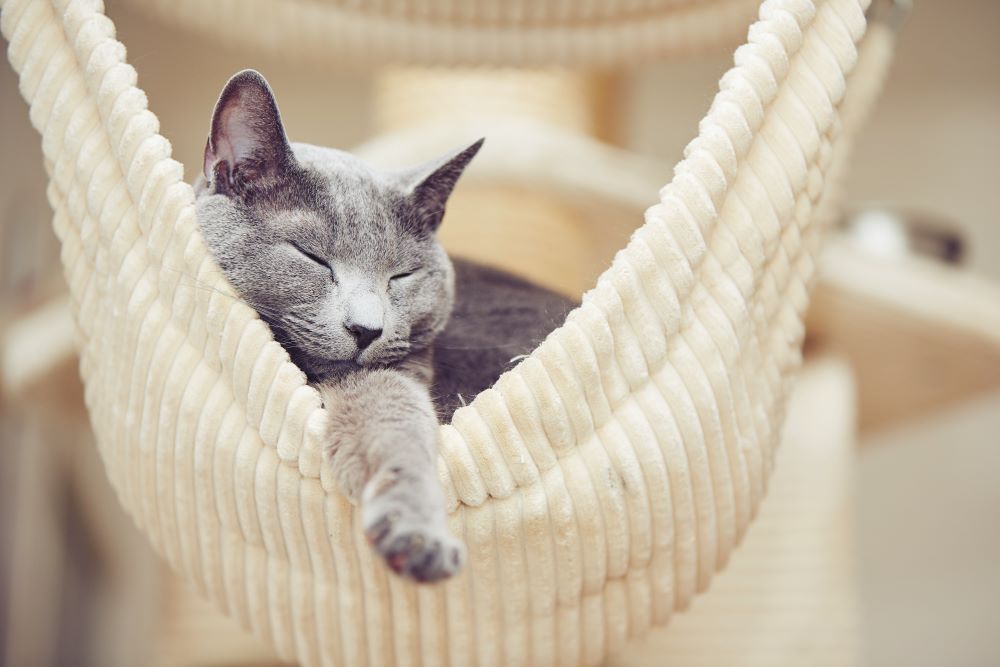Get Pet Insurance for your Cat & Dog

Zero
Documentation
Quick
Claim Process
Affordable
Premium
Terms and conditions apply*
- {{species}}
- {{indoorOutdoor}}
- {{suminsured}}
Russian Blue Cat Breed Characteristics & Information

Welcome to the fascinating world of Russian Blue cats, where elegance and charm converge in a sleek, silver-blue coat and captivating emerald-green eyes.
Known for their distinctive appearance and gentle demeanour, Russian Blue cats are more than just a breed; they are a symbol of grace and sophistication.
In this brief exploration, we'll delve into the unique characteristics and alluring personality that make Russian Blue cats a beloved choice among cat lovers.
What is the Origin of Russian Blue Cats?
The history of Russian Blue Cats is a tale woven through the fabric of time, originating in the cold reaches of Russia.
This enchanting breed is believed to have made its first appearance in the port of Arkhangelsk. Russian Blue cats were cherished by Russian royalty, finding their way into the hearts of aristocrats and czars.
Over the years, these felines have transitioned from regal companions to cherished pets, maintaining an air of mystery and grace that continues to define the Russian Blue cat.
What are the Characteristics of Russian Blue Cats?

It is important to know the characteristics of Russian Blue cats to ensure you can provide them with the best care. Here are some key points to keep in mind:
- Lifespan: With proper care and attention, Russian Blue cats have a lifespan of around 15 to 20 years. Regular veterinary check-ups, a balanced diet, and a healthy lifestyle contribute to their longevity.
- Height: Russian Blue cats are of medium size, i.e., 25 cm or 10 inches, presenting a graceful and proportionate physique. Their average height contributes to their overall elegant appearance.
- Colour and Coat: The hallmark of the Russian Blue is its shimmering silver-blue coat, which is short, dense, and plush to the touch. The coat's bluish hue is complemented by silver-tipped guard hairs, creating a luxurious and regal appearance.
- Weight: Males typically weigh between 4.5 to 5.4 kg, while females range from 3.1 to 4.5 kg. This moderate weight adds to their agile and nimble build, allowing them to move with grace and fluidity.
- Behaviour and Personality: Russian Blue cats exhibit intelligent and inquisitive behaviour. Their quiet and reserved nature adds to the serene atmosphere they bring to a household.
- Living Condition: Russian Blue cats are sensitive to changes and may initially seek a quiet space until they acclimate to their surroundings. Gradual introductions and a calm environment aid in their transition.
- Temperament: They enjoy interactive play but are not overly demanding. These felines appreciate routine and can be sensitive to changes in their environment. They are known to be relatively quiet, adding to their peaceful presence.
- Breed Group: Russian Blue cats belong to the Foreign Shorthair group. This classification reflects their elegant physique and short, well-groomed coat, distinguishing them from other feline breeds.
How to Train Russian Blue Cats?
Training Russian Blue cats requires a patient and positive approach. Here are essential points for effective training:
- Behavioural Training: Russian Blue cats respond well to positive reinforcement. Reward desired behaviours with treats, praise, or affection. Avoid punishment, as it may lead to stress or fear. Consistency and patience build a trusting relationship.
- Leash Walk: Begin leash training indoors and use a lightweight harness and leash. Allow them to explore while gently guiding them with the leash. Gradually transition to outdoor walks, ensuring a calm and controlled experience.
- Scratching Posts: Introduce a variety of scratching posts with different textures. Encourage your Russian Blue to use them by placing treats or catnip nearby. If they attempt to scratch furniture, gently redirect them to the designated post.
- Litter Box Training: Russian Blue cats are generally fastidious, making litter box training relatively straightforward. Choose a quiet location for the litter box and keep it clean.
- Socialisation: Expose your Russian Blue to various people, sounds, and environments to foster socialisation. Start gradually, allowing them to acclimate at their own pace. Positive experiences build confidence and reduce anxiety.
What are the Health Problems with Russian Blue Cats?

While Russian Blue cats are generally known for their robust health, they may be prone to certain health issues. Here are six common health issues:
- Obesity: Russian Blue cats can be prone to obesity, especially if their diet is not properly regulated. Maintaining a balanced diet, portion control, and regular exercise help prevent weight-related issues.
- Respiratory Infection: Russian Blue cats may be susceptible to respiratory infections, such as feline herpesvirus. Keeping their living environment clean and ensuring they receive proper vaccinations can reduce the risk of respiratory illnesses.
- Hypertrophic Cardiomyopathy (HCM): HCM is a heart condition that can affect Russian Blue cats. Regular cardiac check-ups are crucial to monitor heart health, as early detection allows for better management of the condition.
- Urinary Tract Issues: Russian Blue cats may be prone to urinary tract issues, including crystals or infections. Adequate hydration through a balanced diet and access to clean water helps promote urinary health.
- Hyperthyroidism: While not exclusive to Russian Blue cats, hyperthyroidism can occur. Regular thyroid screenings during veterinary check-ups assist in the early detection and management of this condition.
- Joint Problems: Some Russian Blue cats may develop joint issues, such as arthritis. Providing a comfortable and warm environment, along with a balanced diet that supports joint health, can alleviate potential problems.
How to Take Care of Russian Blue Cats?
Russian Blue cats are not high-maintenance cats, but they do require some basic care to stay healthy. Here are some tips:
- Diet and Nutrition: Provide a well-balanced, high-quality cat food that meets the specific nutritional needs of Russian Blue cats. Consider giving them chicken, fish, turkey, etc., which they love to eat.
- Feeding: Russian Blue kittens (up to 6 months) should be given 3-4 meals per day of more than 200 calories. An adult Russian Blue Cat (6 months and older) should be fed two meals per day of 180-200 calories.
- Grooming: Russian Blue cats have short, dense fur that requires regular grooming to minimise shedding and hairballs. Brush their coat at least once a week using a soft brush to maintain its lustrous appearance.
- Ear Care: Check your cat's ears regularly for signs of dirt, wax buildup, or redness. Gently clean their ears with a veterinarian-approved ear cleaner using a cotton ball or pad. Avoid inserting anything into the ear canal.
- Exercise: Engage Russian Blue cats in interactive play sessions to stimulate their intelligence and maintain a healthy weight. Toys that encourage jumping, chasing, and pouncing cater to their playful nature.
- Dental Hygiene: Implement a dental care routine to prevent dental issues. Brush your cat's teeth regularly using a cat-specific toothbrush and toothpaste. Dental treats or toys designed to promote oral health can complement brushing.
- Bathing: Russian Blue cats generally do not require frequent baths. If bathing becomes necessary, use a cat-friendly shampoo and ensure a calm environment. Introduce them to bathing gradually.
Russian blue cats, with their distinctive features, embody grace in every whisker. As we explore their unique characteristics, health considerations, and the art of companionship, it becomes evident that Russian Blue cats aren't just pets; they are cherished members of our households, bringing joy and sophistication into our lives.












